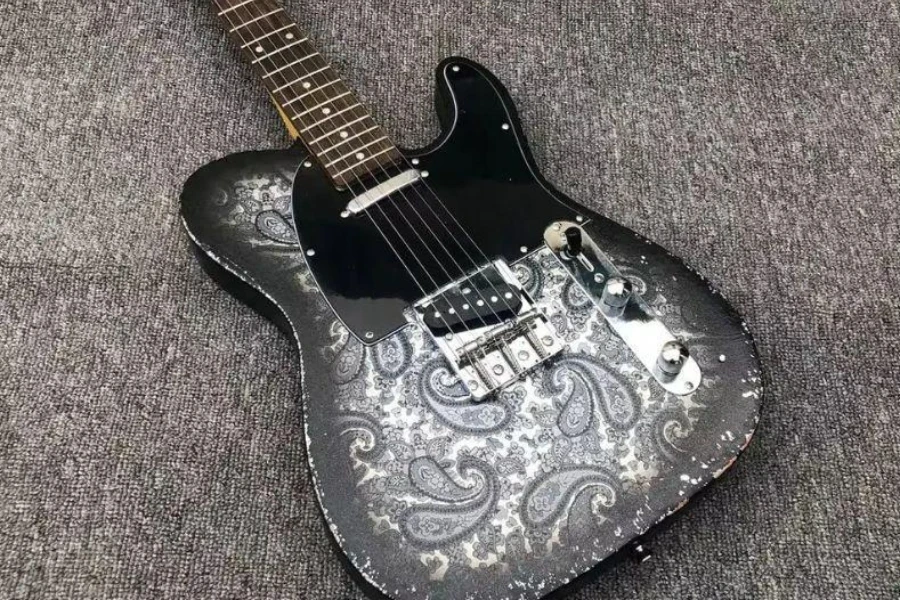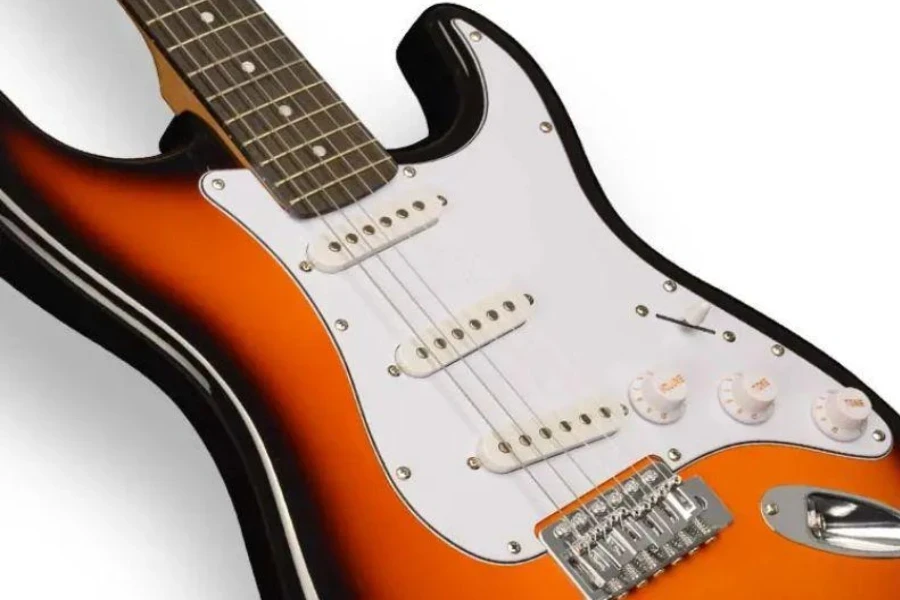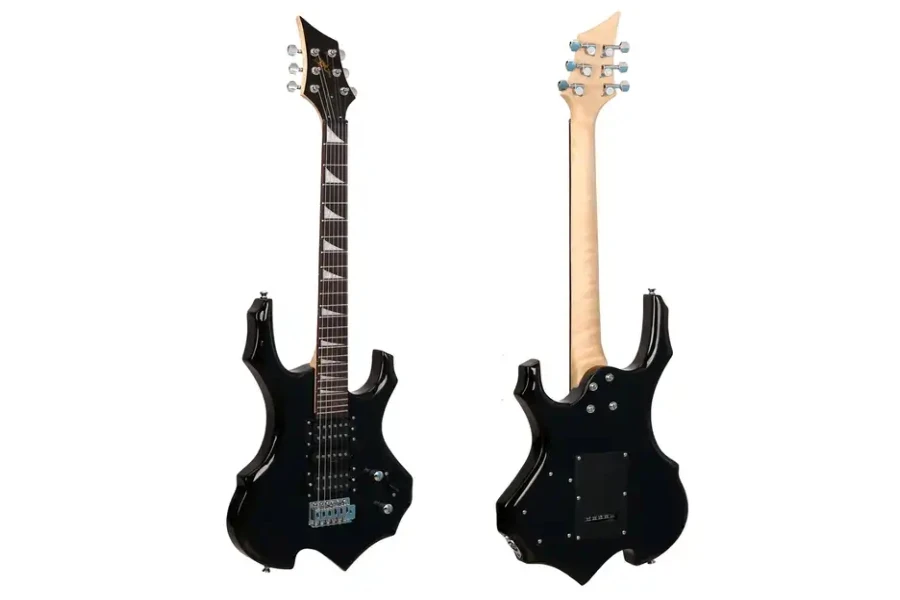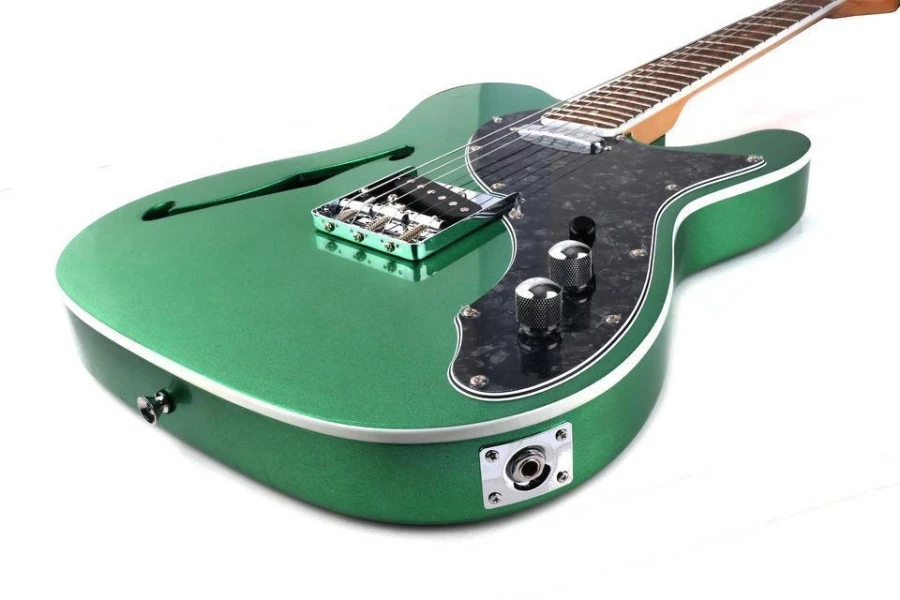Electric guitars have been rocking the music scene since the early 20th century, playing a crucial role in the shaping of modern music. In fact, they are more than mere instruments, they’re a significant symbol of a cultural revolution in the music industry.
Unlike acoustic guitars, electric guitars are typically easier to play, thanks to their smaller bodies and lower string action. This simplicity makes them popular among beginners and experienced guitarists alike.
For businesses, this ever-growing popularity presents a perfect opportunity to tap into a thriving niche. However, to make the most of this, sellers should not only stock a diverse range of options, but also keep up with the latest trends and technologies to align their products with consumer needs.
This guide will help you understand which types of electric guitars you should stock in 2024.
Table of Contents
Electric guitar market overview
Types of electric guitars
Important factors to consider when stocking electric guitars
Conclusion
Electric guitar market overview
The global electric guitar market has grown significantly over the years and continues to thrive. In 2021, it was valued at US$ 3.9 billion, according to Straits Research. However, it is anticipated to reach US$ 6.93 billion by 2030, growing at a compound annual growth rate (CAGR) of 6.6%.
This remarkable growth is driven by two factors. Firstly, many people are becoming music lovers, with a particular interest in learning and playing the electric guitar. This trend is not limited to experienced musicians but also beginners who increase the demand for entry-level electric guitars.
The increasing number of live concerts and music festivals has also contributed to the high demand for electric guitars. Their small bodies, thin necks, and easy amplification make them easy to carry and operate, increasing their appeal to musicians.
Types of electric guitars
Solid body electric guitars
Solid body electric guitars are the most popular among musicians. They produce a clean and consistent sound while remaining largely free from feedback issues. This combination makes them the preferred pick for musicians of all levels.
According to Google Ads, solid body guitars are very popular. Their average monthly searches in the past year increased by 8.33%. For businesses, offering a diverse selection of solid-body electric guitars will help them meet the needs of a wide customer base, consequently increasing sales.
Here are examples of solid body guitars and their features:
- S-type (Fender Stratocaster shape)
The S-type electric guitar has an iconic Stratocaster shape. This design ensures that players can comfortably perform for long periods without getting tired.
In addition, it features a synchronized tremolo system, also known as the whammy bar. This system allows for pitch modulation and the creation of unique sonic effects.
- T-type (Fender Telecaster shape)

The T-type electric guitar not only has a distinctive appearance but also enhances playability. Its solid single-cutaway body allows guitarists to comfortably access the higher frets for ease of play. It also offers sharp tones suitable for country, rock, and blues music genres.
- LP-type (Gibson Les Paul shape)

The LP-type electric guitar features a pair of humbucking pickups that reduce noise to deliver a warm tone. The guitar also has two coils on its body in opposite directions to cancel out the interference associated with single-coil pickups. This suits musicians and guitarists who prefer versatility and sonic clarity.
- SG-type (Gibson SG shape)

The SG-type electric guitar is lightweight and has a slim neck, thanks to the Gibson SG shape. This design allows musicians and guitarists to play comfortably, even during long performances. Moreover, like most solid body electric guitars, the SG-Type delivers precise, clear tones suitable for all music genres.
- Explorer type (Gibson Explorer shape)

Much like the S-type’s tremolo system, the Explorer type has advanced features that open up new sonic possibilities. For instance, it makes sound modulation and effect creation versatile to help musicians experiment with a variety of sound effects. This capability makes it popular among those who want to achieve unique sonic expressions.
Moreover, the guitar’s compact shape fits in most travel bags. This feature suits travelers and musicians who are always on the road.
- V-type (Gibson Flying V shape)

As the name suggests, the V-shaped electric guitar features a distinctive Gibson Flying V design. This unique body structure is characterized by sharp, angular wings that resemble the letter “V.” This design brings out a modern look that appeals to the younger generation. It also facilitates easy access to the higher frets, which is useful for guitarists who engage in technical playing styles.
- Offset-type

Offset-type electric guitars include Fender Jaguar and Jazzmaster. Each guitar model offers its own unique tonal characteristics. For instance, the Fender Jaguar has sharp tones that bring out clear and precise sounds.
On the other hand, the Jazzmaster offers an entirely different tonal experience. Its tones are warm and smooth, allowing it to deliver an experience of richness and versatility.
Semi-hollow body electric guitars

Semi-hollow body electric guitars are light and have better tonal qualities than solid body models. Moreover, they have a classic design that features f-holes on the front. This appearance allows for air movement within the guitar for better sound quality.
According to Google Ads, the average global monthly searches for semi-hollow body electric guitars over the past 6 months increased by 8%. Stocking them will help you to cater to this rising demand.
Hollow-body electric guitars

Like semi-hollow body models, hollow body electric guitars have f-holes on the front body. The holes produce acoustic sounds with precise tones, making these guitars suitable for specific musical genres like jazz.
Hollow-body guitars are also very popular. According to Google Ads, their average monthly searches in the past year increased by 8.17%. Having them in your inventory will not only increase sales but will also broaden your customer base.
Important factors to consider when stocking electric guitars
Audience and demographics
Understanding your audience and demographics is one of the most important factors when choosing which guitars to stock. This means getting to know your potential customers and what they’re looking for in a guitar. For example, businesses can consider whether their audience consists of beginners, intermediate players, or professionals. Or, on the other hand, they may opt for a selection that caters to each of these groups to ensure they meet the needs of a broader customer base.
Quality and craftsmanship
Each guitar’s quality and craftsmanship should be a top consideration when building your inventory. You need to know the individual materials used in the guitar’s construction as they will impact their playability.
Craftsmanship is equally essential. A well-crafted guitar will have smooth fretwork and well-finished edges. These elements enhance the overall customer experience and satisfaction.
Tone and sound
Consider the pickups and tonewoods used in the guitar’s construction as they contribute to its tonal characteristics. For instance, single-coil pickups are clearer than humbuckers, which offer thicker sounds.
In addition, if your audience includes blues and jazz lovers, consider mahogany tonewood as it produces warm tones. If otherwise, go for guitars made of maple, especially for rock and pop lovers.
Aesthetic and design
How a guitar looks, from its design to its finish, often influences a musician’s decision to purchase. As a result, sellers and retailers must stay up to date with current design and color trends to remain competitive.
For instance, some musicians may prefer vintage guitar designs that bring out timeless looks. On the other hand, others would prefer minimalist designs that capture the attention of those drawn to modern style.
By stocking different designs, businesses will thrive as they’ll attract a broader customer base, each looking to match their unique style.
Price point and range
The price points are also important to consider. Ideally, some musicians may have a strict budget, while others may be more willing to invest in high-end instruments. As such, you should offer a wide range of price points within your inventory to cater to these diverse buyers.
After-sale services and warranty
Businesses that offer after-sale services often find themselves ahead of the competition. These services may include setup and maintenance services, as well as assistance with technical issues. Offering these after-sales services goes a long way in building trust with customers.
Equally important is the warranty policy. Some policies only cover manufacturing defects, while others extend to parts replacement. As a seller, you should stock products with favorable policies for your customer base.
Conclusion
The guitar market has seen remarkable growth to meet the changing demands and customer preferences. Electric guitars, in particular, have become central to this growth, signifying a shift towards a more personalized and expansive musical experience.
For businesses, the key is staying in tune with these changes. This means understanding and responding to the diverse needs of guitar players. Whether they prefer classic models or cutting-edge designs, you should aim to have something for everyone in your inventory.
The goal is to ensure customer satisfaction by attending to your customers’ individual needs. This way, you can easily build trust, reliability, and a lasting customer-business relationship.








